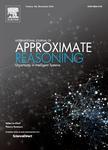版权所有:内蒙古大学图书馆 技术提供:维普资讯• 智图
内蒙古自治区呼和浩特市赛罕区大学西街235号 邮编: 010021

作者机构:Univ Castilla La Mancha Dept Comp Sci Albacete 02071 Spain Univ Almeria Dept Appl Math & Stat Almeria 04120 Spain
出 版 物:《INTERNATIONAL JOURNAL OF APPROXIMATE REASONING》 (国际近似理论杂志)
年 卷 期:2010年第51卷第5期
页 面:515-530页
核心收录:
学科分类:07[理学] 0701[理学-数学] 0812[工学-计算机科学与技术(可授工学、理学学位)] 070101[理学-基础数学]
主 题:Machine learning Graphical models Learning from incomplete data
摘 要:Probabilistic Decision Graphs (PDGs) are a class of graphical models that can naturally encode some context specific independencies that cannot always be efficiently captured by other popular models, such as Bayesian Networks. Furthermore, inference can be carried out efficiently over a PDG, in time linear in the size of the model. The problem of learning PDGs from data has been studied in the literature, but only for the case of complete data. We propose an algorithm for learning PDGs in the presence of missing data. The proposed method is based on the Expectation-Maximisation principle for estimating the structure of the model as well as the parameters. We test our proposal on both artificially generated data with different rates of missing cells and real incomplete data. We also compare the PDG models learnt by our approach to the commonly used Bayesian Network (BN) model. The results indicate that the PDG model is less sensitive to the rate of missing data than BN model. Also, though the BN models usually attain higher likelihood, the PDGs are close to them also in size, which makes the learnt PDGs preferable for probabilistic inference purposes. (C) 2010 Elsevier Inc. All rights reserved.